Is this the best way to see Japan? The luxury cruise that's re-writing the rules
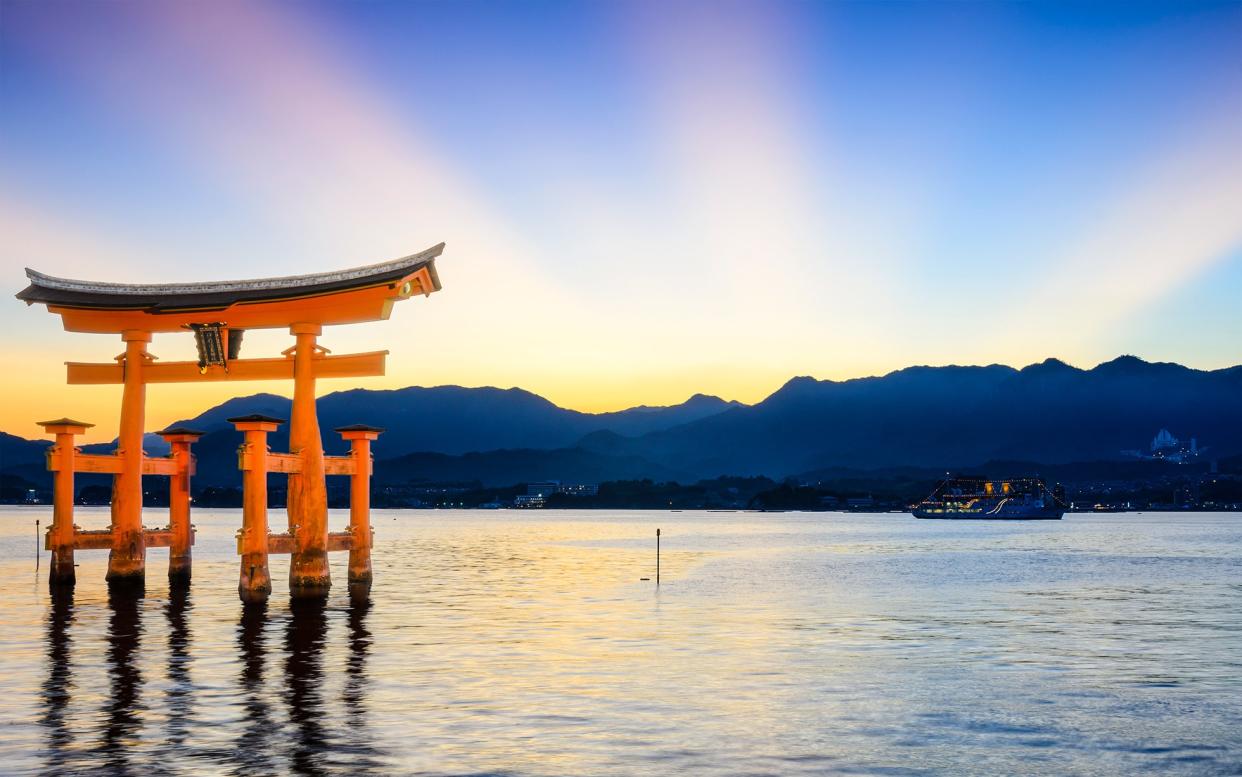
My eyes are following the fingers of a Japanese sweet master as they dance across a wooden counter with the dexterity of a concert pianist – brushing, scooping, pressing and tapping a cloud-like puff of peach powder. The faster his fingers move, the more time seems to slow… until, with a polite dip of the head, his work is done.
I am sitting, shoeless, on a bamboo stool which the maestro now approaches – placing before me a cup of green tea and a diminutive wagashi (a traditional sweet), which dissolves on my tongue in a fleetingly light fuzz of sweetness.
The presentation of handmade sweets with tea may sound like the kind of centuries-old ritual that unfolds inside a Kyoto tea house or remote mountain ryokan inn. But the slide of a nearby paper screen reveals not the tree-filled or rock garden tableau one might expect, but a sun-flecked expanse of deep, blue water. My floating tea ceremony has taken place on board guntû, one of the most exquisitely crafted – and luxurious – ships ever to set sail in Japan.
There’s just under one year to go until Japan, home of the Brave Blossoms team, hosts the Rugby World Cup 2019. With the countdown now under way for both the World Cup and the 2020 Tokyo Olympics, Japan is preparing to take centre stage. A flurry of new flights and hotel openings is the tip of the iceberg: the dispersion of matches across 12 cities – most linked by shinkansen (bullet trains) – means that experiences won’t be confined to the tourist trails of Tokyo and Kyoto, but will be found in even the most hidden corners of the archipelago.
And so it was that I found myself in a floating tatami mat room on the Seto Inland Sea watching the nimble fingers of a sweet maker. With its clean lines and minimalist design and a philosophy deeply rooted in the traditional art of Japanese hospitality, guntû (pronounced “gan-su” and inspired by a small local crab) is rewriting the rules of luxury cruising. Catching sight of the boat for the first time, the simplicity of its smooth wooden facade and single peaked roof brought to mind an oversized Noah’s Ark children’s toy.
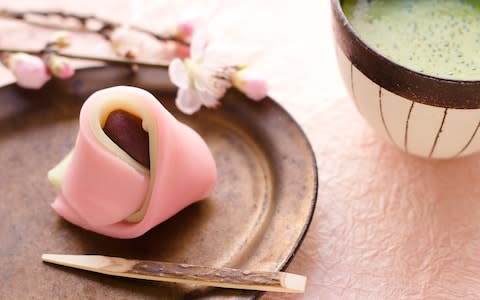
Biblical references soon faded as my eyes took in the cool whiteness of its modern lobby. Staff greeted me with a flurry of bows and chilled white towels as I craned my neck to take in the high ceiling, a scene-stealing ribbon-style staircase in the centre and the sole decoration – a single vase of flowers on an organic twist of tree trunk.
The brainchild of a wealthy local shipbuilding family and masterminded by Tokyo architect Yasushi Horibe, guntû is an unadulterated showcase of contemporary Japanese craftsmanship, from the gently tilted roof in smooth woods (11 different types were used on board) and bamboo stools to the tatami cushions lining one side of the boat that brings to mind the serene outer corridor of a traditional Japanese house.
Guntû is as diminutive as it is stylish, with 38 guests accommodated in 19 cabins (comfortably outnumbered by 46 staff). The three decks accommodate a restaurant, onsen-style wooden baths and a sushi counter. Away from the ship there are fishing trips and excursions to islands. Competing for attention with the design is the setting: we sail across the Seto Inland Sea, a green-blue expanse of water speckled with thousands of tiny islands.
The Japanese art of omotenashi (the translation to “hospitality” barely scratches the surface) is embodied by unwaveringly intuitive staff in minimal taupe uniforms. Staff member Yoko-san showed me to my second-floor room, where I swapped shoes for slippers before entering a modern take on a cruise cabin. Swathes of warm chestnut wood walls and ceilings cocooned me as I took in the decked balcony and white bathroom with plants, organic toiletries and a deep bathtub with a sea view.
Yoko san produced a tablet showing how everything works (from boat routes to safety information), before gesturing to fridges containing juices, wines and snacks: “And don’t forget that everything is free.” With that, guntû let off seven short, sharp toots and I ventured up top just in time to see the ship depart at a leisurely pace (its average speed is just 10 knots) as staff discreetly dispensed glasses of champagne. I got my bearings quickly thanks to a simple and compact layout. The top floor has a wooden deck at the front, a restaurant and bar in the centre and a serene lounge, where shoes are slipped off, at the rear.
As we edged away from the small marina and out to sea, views of waving locals and small coastal towns fringed by green mountains were swapped for a skyline delicately imprinted with the silhouette of distant islands.
It’s the kind of setting that invites instant relaxation: I promptly sank on to a seat, put down my notepad and enjoyed the view – before a staff member politely reminded me of my spa appointment.
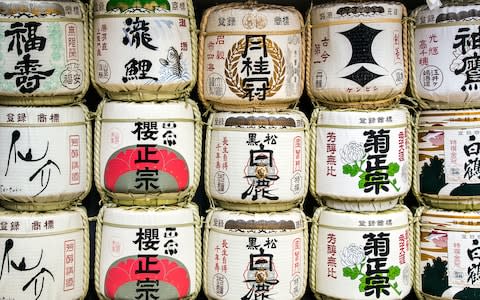
The sun was starting to sink as I emerged with messy post-massage hair, just in time for dinner at the sushi restaurant. Squeezing into the six-seat counter and watching white-hatted chef Jitsukawa work his magic, the setting felt familiar, yet unfamiliar – the twist being that the partly opened sliding screens behind him revealed deep pink skies and a darkening sea.
The flavours of Setouchi were the order of the day. Jitsukawa placed a string of delicious morsels before me – tai sea bream, hamo pike conger and tako octopus among them. Some melted in the mouth, some were chewy, others left a hint of the sea on my tongue. All were accompanied by tiny ceramic cups of smooth, sweet local sake.
Afterwards, I ran into the architect Horibe-san, who was dining in the main restaurant. “If you can, just forget about everything when you’re here,” he said. “This is a place for simply enjoying the moment.”
Following his advice, I enjoyed a quick nightcap in the bar, followed by a bath and a stargazing moment on my balcony, eventually falling into a deep sleep, gently rocked by the sea beneath me.
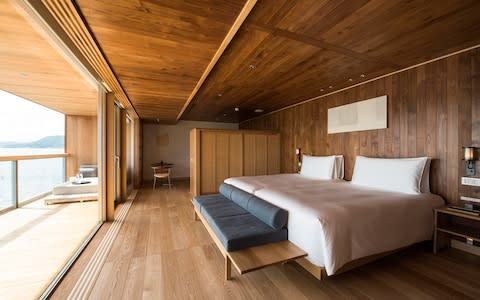
There was a good reason for the 6am alarm call the next morning: an excursion to Miyajima, a small island near Hiroshima, which is famously home to Itsukushima-jinja, a “floating” World Heritage shrine whose red gate is often surrounded by sea tides. And almost as famous as the shrine? The crowds that flood it daily, hence our early start. After bouncing across the waves James Bond-style in a cream speedboat, we arrived to find Miyajima deliciously deserted, bar a couple of deer. Savouring the priceless luxury of a near-private visit, we wandered along narrow, empty lanes and past temple pagodas, before arriving at the distinct scarlet architecture of the shrine.
Passing a solitary sweeping monk, we explored the network of wooden walkways, stopped to clap hands and toss coins into altars and, as the tide began to flow in, posed for pictures in front of that gate (where visitors often queue for hours for such a snapshot). After a quick tea and cake stop, just as crowds start trickling off ferries, we sped off back to guntû for breakfast.
Exploring the Setouchi region felt a million miles from the skyscrapers of Tokyo and Osaka: there is something deeply soothing about this smooth, temperate expanse of water, which not only lies between three of the four main islands that make up Japan, but is also fringed by close to a dozen prefectures
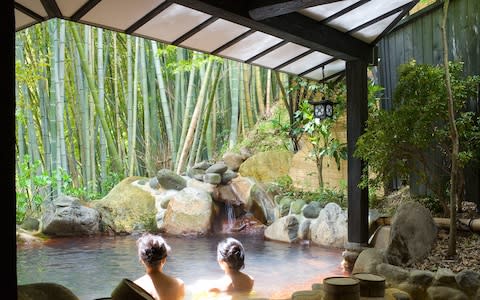
The rest of the trip passed in a relaxed blur – I stared at the sea, while soaking in onsen-style wooden baths, yellow lemons bobbing on the surface; I met fishermen visiting guntû’s jetty with daily catches (which later reappeared, some still twitching, on a bamboo tray at dinner); we explored tiny Kashiwa island, where locals let us sample sun-dried seaweed with disposable chopsticks (verdict? fresh and salty); and, of course, I slipped off my shoes and lost track of time during an on-board sweets ceremony.
On my last night – post-bath and pre-bed – I found myself sitting on my balcony in one of the boat’s stylish grey kimono-style gowns, simply staring at the moon, savouring the cool breeze and listening to the gentle soundtrack of the water beneath me. And, with my notepad somewhere at the bottom of my bag, I’m pretty certain that Horibe-san would have thoroughly approved.
Essentials
Guntû (guntu.jp) operates one to three-night trips across the Seto Inland Sea, costing from 400,000 yen (£2,680) per night for two passengers, including all on-board meals and activities. The ship departs from Bella Vista Marina, around 90 minutes by car from Hiroshima airport.
The writer travelled as a guest of Setouchi Tourism Board (setouchitrip.com) and Black Tomato (020 7426 9888; blacktomato.com). Black Tomato can arrange luxury tailor-made Japan trips, including visits to Tokyo, Kyoto and two nights on board guntû from £8,550pp. This includes a night at each of the Palace Hotel Tokyo and Ritz-Carlton Kyoto on a B&B basis, a three-day cruise, bullet train tickets, transfers and private tours in Tokyo and Kyoto.
What to see and do in the Rugby World Cup year
1. Sapporo
The capital city on Japan’s northernmost island Hokkaido is foodie nirvana – particularly in the autumn (when the World Cup fixtures take place here). Don’t miss September’s Sapporo Autumn Fest in central Odori Park, which runs through the heart of the city, with treats ranging from fresh seafood and ramen to quality nihonshu sake. (sapporo-autumnfest.jp)
2. Tokyo
The capital’s historic Hotel Okura will reopen next September in the Toranomon district, under a new name: The Okura Tokyo. It will be housed in two shiny new skyscrapers that aim to elevate the city’s luxury offerings to new heights. (hotelokura.co.jp/tokyo/en)
3. Kobe
Forget post-rugby beer drinking. Sip some of Japan’s finest nihonshu sakes in Kobe, a city famed for its quality production, and perhaps go behind the scenes with a tour (and tasting) at the Hakutsuru Brewery, which dates back to the 18th century. (hakutsuru.co.jp/english)
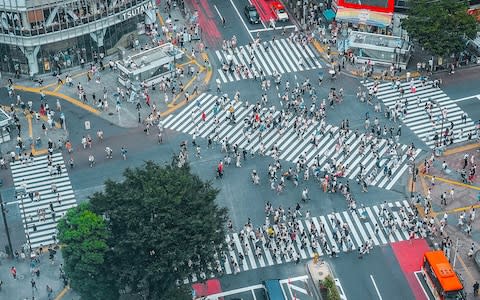
4. Fukuoka
Among a flurry of scheduled new hotels opening across Japan is the Miyako Hotel Hakata in southern Fukuoka, which is due to launch next autumn – just in time for the rugby. The new hotel has a contemporary glass facade, with an in-built waterfall plus countless green plants and hot-spring bathing.(miyakohotels.ne.jp/hakata/english/index.html)
5. Shibuya
Busy Shibuya Station in Tokyo, famed for its night-time neon lights and packed diagonal zebra crossings, is in the throes of a lengthy overhaul. Next year’s visitors will see the first of them – including one of the city’s tallest observation decks, 755ft (230m) high and perched atop a new skyscraper.
6. Oita
Located on southern Kyushu island, Oita Prefecture has long been famed for its onsen culture. Its bathing credentials will step up a luxury notch next year, with the opening of the ANA InterContinental Beppu Resort and Spa.
7. Yokohama
More and more people are choosing to cruise around Japan – it’s a great way to see the key sights without the hassle of booking trains and accommodation. The busy port city of Yokohama (home to the biggest stadium in Japan, with capacity for 72,327) is ramping up its offering with a new cruise terminal complete with shops and a hotel. While here, visit the Kirin brewery which has been brewing since 1888.
8. Kumamoto
The southern city’s historic hilltop castle – among the most famous in Japan – is currently under wraps after being badly damaged in a series of earthquakes, but the scaffolding is finally due to be removed from the main tower in autumn 2019: just in time to appreciate the beauty of the castle complemented by fiery seasonal foliage. (kumamoto-guide.jp/kumamoto-castle).
9. Iwate
The final leg of the Sanriku Railway Rias-line in Iwate Prefecture – a sightseeing route along the picturesque anriku coastline – is due to reopen next March after sustaining extensive damage in the 2011 earthquake and the ensuing tsunami. The trains are as eye-catching as the surrounding scenery – there is the Tatami train, with mat flooring; an old school retro train; and even a Kotatsu train, so-called on account of its cosy tables with in-built heating. (sanrikutetsudou.com)
10. Osakaa
Access to the lively capital of the western Kansai region will become even easier from next spring, with the launch of direct British Airways flights between London and Osaka Kansai International Airport (ba.com)

